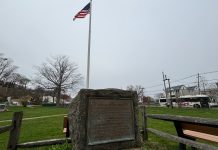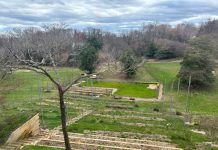By John Burton
WALL – For the veterans who are working to restore a Vietnam–era combat helicopter, the experience is bringing back strong emotions and memories.

foundation’s Vietnam Era Museum and Educational Center in Holmdel.
“You’re talking about a pretty intense part of my life,” said Ken Gurbisz, a former U.S. Army warrant officer who flew a similar helicopter in-country more than 40 years ago.
Gurbisz was on hand Monday in a hangar with about 15 other veterans at Monmouth Executive Airport, Highway 34.
The veterans, mostly from the Vietnam War – two served in Afghanistan – are working to restore a 1964 Bell UH-1D Iroquois helicopter, which is usually referred to as a “Huey.”
They have been working since winter to put back into reasonable shape the helicopter that for them – and probably countless others – holds emotional significance.
The type of helicopter is “not only a physical symbol of the Vietnam War,” said volunteer Carl Burns, but it is also “an emotional symbol.
“The sights and the smells” of the craft have brought back all sorts of thoughts and feelings for those working on it, acknowledged Burns, a Manalapan resident who flew one as an Army captain in 1966-67.
The volunteers “all had tears in our eyes,” when they first saw it, even though it was nothing but a hollowed shell at the time, Gurbisz said.

helicopter that served two tours in Vietnam. Sarah Hagarty (front) is the program director for the memorial foundation.
In January, the New Jersey National Guard offered the helicopter to the New Jersey Vietnam Veterans’ Memorial Foundation for its permanent display at the foundation’s Vietnam Era Museum and Educational Center, located on the grounds of PNC Arts Center, Holmdel.
The craft, which served two tours of duty in Vietnam, first from October 1966 through September 1967 when it was assigned to the 116th Assault Helicopter Company and then from November 1968 to February 1970 with the 25th Infantry Division. While with the 25th, it was located at Cu Chi, which was 30 miles northwest of Saigon, said Burns, who also served in that area with the 25th during his tour.
The helicopter was seriously deteriorated.
“You have to remember it sat in a field for 20 years,” at Fort Dix, Gurbisz said. “We had many bird’s nests and hornet’s nests to get rid of.”
The volunteers all have connections to this style of aircraft. That “has been great, because they know how to work on them or know how to fly them,” said Sarah Hagarty, program director for the memorial foundation.
So far the group, which meets every week at the airport hangar to work on the project, has spent a collective 1,500 hours to restore it, Hagarty said.

The project began with removing the Desert Storm-era tan camouflage, to restore it to its original olive drab exterior. “That was a lot of sanding,” Gurbisz said. Afterward, the work has been cleaning and refurbishing to make the interior presentable for what will be an authentic, fixed display for visitors, especially for the school-age children, who visit the memorial and museum.
The group has been collecting spare parts from wherever it can get them, Hagarty and Gurbisz said.
It looks as though there will be enough parts to sufficiently restore the craft’s cockpit to allow visitors to sit in it. The volunteers hope to be able to raise enough money to restore it and have it ready for an unveiling on May 7, 2014, which is the state Vietnam Veterans Remembrance Day. The group also hopes to also be able to afford to install a simulator in the cockpit to give visitors a realistic appreciation of what it was like to fly in such an aircraft.
“It’s a pretty tall order,” Hagarty said about the work that needs to be done.
While the project has received some support with organizations and individuals contributing funds and parts, the overall project will cost between $150,000-$200,000, according to Hagarty.
This week the museum is beginning its KickStarter campaign to assist in fundraising efforts for the project’s completion.
For these guys – the group of volunteers is all male – this is an important project in terms of the nation’s history and their own.
“When I first saw this, it was a ton of flashbacks,” Gurbisz said. “I was one of those 20-year-old warrant officers” assigned to Vietnam’s Central Highlands region, flying Hueys on rescue and recovery missions.
Burns, who authored the memoir Centaurs in Vietnam: Untold Stories of the First Year, remembered how he was flying a Huey during his tour of Vietnam when he, his crew and the craft started taking on enemy fire.
“They were in their spider holes firing – ping, ping, ping,” went the shots as it hit the helicopter shell, Burns said, noting his crew was operating the helicopter’s machine guns, strafing the area. Enemy fire then caught the tail rudder and the craft began twisting, eventually crashing in a rice paddy. Thankfully, he and the four-member crew all survived, he said.
There were about 3,000 of these helicopters at any given time operating in Vietnam, playing a vital role in that conflict, Gurbisz said. There were a total of roughly 14,000 in use over the course of the war of which about 6,000 didn’t make it out, Burns said.
“I left one there,” he said.
Young visitors to the museum will “get a sense of the war,” and its significance from the site’s multimedia presentations and existing displays. “But, they don’t really understand the role of the helicopter, the magnitude of it,” Gurbisz. “It brought guys in. It carried them out. It brought supplies” and transported the wounded during its active combat role, Burns said. “It brought them beer,” he said with a slight smile.
“It was part of you,” for that time in their lives, Burns said.
For more information about the project, visit www.njvvmf.org.














